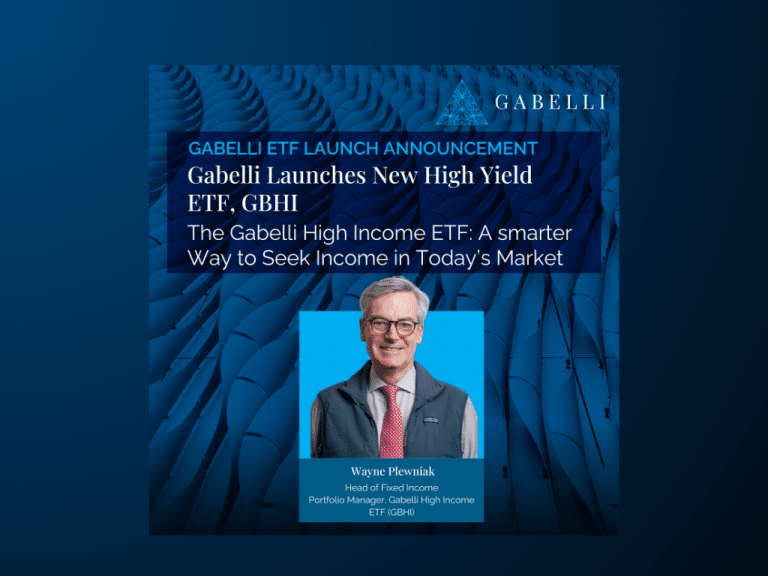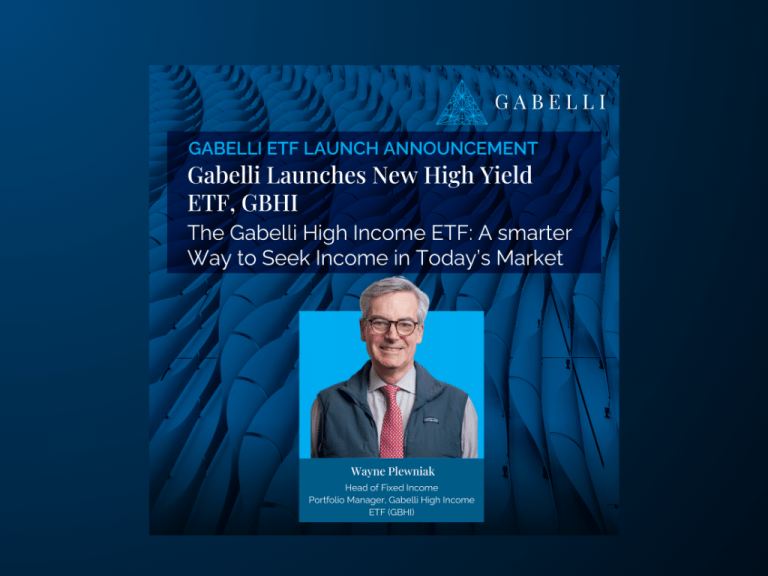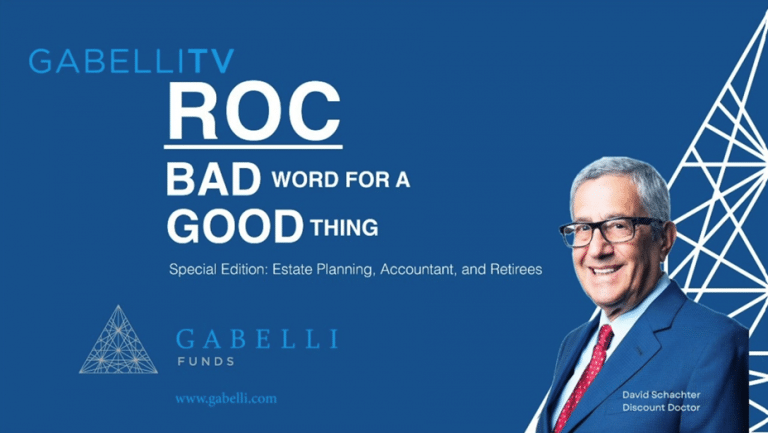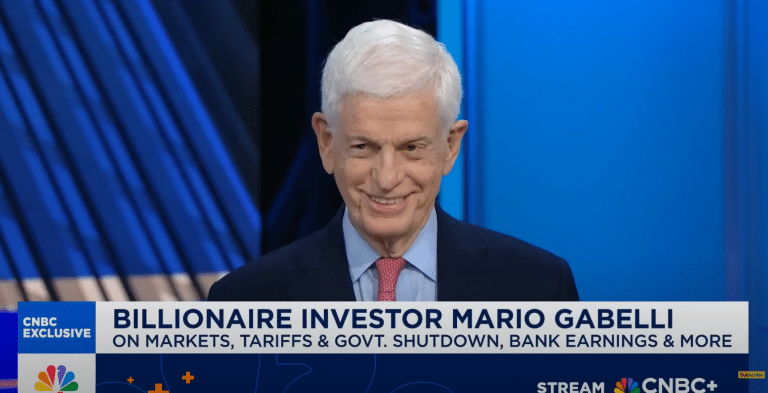Navigating Turbulent Markets: Challenges and Opportunities
In recent weeks, global financial markets have experienced heightened volatility, reminding investors of the interconnected nature of today’s financial systems. The recent turbulence is largely attributed to a combination of macroeconomic concerns, technical factors, and diverging policy decisions by global central banks.
For nearly five decades, our seasoned portfolio managers at Gabelli have navigated the ebbs and flows of global financial markets. Our long history of weathering market cycles underscores our belief in the importance of fundamentals, particularly during periods of heightened volatility. As recent market turbulence rattles investor confidence, our experience and disciplined approach allow us to identify enduring value amid the noise.
In the following sections, our portfolio managers will provide their insights and analyses on the latest market developments, offering a comprehensive view of the current landscape, sector specific insights, and their strategies for managing investments during uncertain market conditions.
Positioned for Change: Volatility, Value Investing, and the Path Ahead
Chris Marangi and Kevin Dreyer, Co-CIOs, Value
Since the beginning of the third quarter, volatility has increased substantially in financial markets. It began with a lower than expected CPI report of +3% (and a -0.1% sequential decline) in early July, leading to increased expectations of a rate cut by the Fed. This also started weakness in the high flying “Magnificent 7” stocks which have driven much of the market’s gains this year, as a long awaited rotation to value and small cap stocks seemed to have finally begun. The volatility continued into August, as recession fears and a rate increase by the Bank of Japan unwound the Yen carry trade (in which investors borrow money at low rates in Japan and invest in the US) sent global equities tumbling.

Markets have since stabilized for the time being, but with the upcoming US Presidential election, an uncertain economy, likely rate cuts by the Fed, and global geopolitical uncertainty, we doubt that volatility has ended. With this backdrop, we believe great businesses with strong free cash flow generation trading at reasonable multiples will be increasingly appreciated by investors. Furthermore, a decline in interest rates may spur a new wave of M&A activity. With our Private Value with a Catalyst approach and focus on small- to mid-capitalization companies, we believe our style of investing is poised to benefit in this environment.
From AI Hype to Economic Reality: Factors Driving Recent Market Swings
John Belton and Howard Ward, Growth Team
Recent equity market volatility stems from several factors simultaneously coming to a head. First, context is important: as of the end of the second quarter the S&P 500 had returned +14% YTD, +23% over the trailing 12 months, and better than 12% per annum since the end of 2019. These strong returns had come despite a recent moderation in economic data: labor market fundamentals have been consistently softening since the end of the first quarter, consumer spending momentum has similarly slowed in recent months, and manufacturing output has been outright weak for much of the last year. Under the surface, investor enthusiasm around the artificial intelligence capital spending environment has been cooling, putting many exposed names trading at over-extended valuation multiples in a vulnerable place. Adding to these factors a collection of more exogenous “ingredients” such as a tenuous situation in the Middle East; political anti-trade rhetoric in the US; crowded and in some cases over-leveraged investor positioning; and a bizarre global IT outage created the “recipe” for a sudden change in risk appetite.
Looking forward, Fed Chair Powell summarized the state of affairs for the US economy well during a hearing with the Senate Banking Committee in July: “We’re not just an inflation-targeting central bank, we also have an employment mandate.” Investors will now be focused on labor market and economic activity indicators, as well as company-specific fundamentals, to gauge whether the recent moderation can be contained, or whether a more concerning slowdown lays ahead. Therefore the market is at a crossroads: is the economy simply going through a period of normalization, with the recent equity market drawdown something which will prove healthy longer-term? Or are we entering into a more prolonged period of weakness for consumers, businesses, and therefore stocks? Now more than ever we will follow the data and attempt to ignore the noise, knowing that company earnings will remain the engine of stock performance over the long term.
Navigating the Short-Term Curve: Strategies in a Changing Rate Environment
Ron Eaker, Co-Portfolio Manager: Gabelli U.S. Treasury Money Market Fund (GABXX)
With more than $5.2 Billion in assets under management in our Gabelli US Treasury Money Market Fund alone, Judy and I are closely monitoring developments on the short end of the U.S. Treasury curve. Through the Federal Reserve’s Open Market Operations, the Fed has a direct influence on short-term interest rates, specifically the Fed Funds rate, and indirectly affects T-bill rates, repo rates, SOFR, and other money market rates. The rest of the curve represents a Mr. Market prediction of future trends.
Market sentiment has shifted dramatically in the past month. In June, the Fed’s Summary of Economic Projections (SEP) indicated one 25 basis point cut through the remainder of 2024. However, following the July meeting where policy was left unchanged, weaker-than-expected employment data, moderating inflation, and global unrest have caused rates to drop significantly. The market, as evidenced by Fed Funds Futures, now anticipates 100 basis points of Fed easing by year-end.
During times of economic and global uncertainty, the bond market benefits from a flight to quality, as investors move away from equities and other riskier assets to the safety of Treasuries and highly rated debt instruments. These periods of negative correlation between stock and bond price movements underscore the importance of fixed income in effective portfolio diversification.
For months, we have anticipated the Fed’s inevitable easing cycle, where monetary policy restrictions will be lifted, and rates hopefully normalized. The exact Neutral Rate (or R*) is uncertain, but if the Fed achieves a soft landing with 2% inflation and full employment, that is the direction we are heading.
In response to this outlook, we have been lengthening maturities. In our money market fund, SEC regulations limit our Weighted Average Maturity (WAM) to 60 days. During the post-COVID rate increases through the first half of 2023, we maintained a shorter duration to capitalize on rising rates through portfolio turnover and new investments. Now, with rates peaking and an easing cycle on the horizon, we have extended maturities to lock in higher rates for a longer period.
For our separately managed accounts, which are not bound by the same restrictions as our money market fund, we have also lengthened maturities by adding 2-year, 3-year, and 5-year positions. This strategy anticipates rates declining in the near term. A fundamental principle of the bond market is the inverse relationship between interest rates and bond prices: as rates decrease, prices increase. The longer the duration, the more we can benefit from capital appreciation and mitigate the risk of reinvesting interest and principal cash flows at lower rates.
Banking Volatility: A Strategic Opportunity for Long-Term Investors
Mac Sykes, Portfolio Manager: Gabelli Financial Services Opportunities ETF (GABF)*
Bank volatility has increased and therefore provides further opportunity for investors that focus on durable, competitive businesses run by corporate leaders with entrepreneurial mindsets. For the first six months of 2024, the S&P Bank Index traded in range of +/- 2%+ for a total of 23 days (Source: FactSet, Gabelli Funds). In the last month, that number is 14 days. There are a number of items creating the volatility including the outlooks for the elections, regulations, consumer trends, and Fed Policy. While some treat volatility as an increased level of risk, we believe systemic industry declines actually can offer improvement in margin of safeties relative to intrinsic values, which over the long-term can be a good thing for expected returns.

A comment about trying to predict interest rates. On January 1, 2024, the implied curve indicated the Fed was going to cut rates 5-6x (25bps each) for all of 2024. On May 19, the curve reflected expectations for 1 cut. July 10, it was 2 cuts. Today, after the movement in rates the market is looking for 5 rate reductions. If we had thought 1/1 was very accurate, we would have been dramatically wrong a few months later. More important, I believe. . . The Fed is on a path to lower rates over time, which should ultimately lead to a normalized yield curve which is good for the banks. Three economists went target shooting. The first missed by a foot to the right, the second missed by a foot to the left and the third exclaimed, “we got it.”
Secondarily, the current decline in rates is not yet appreciated for derivative effects. Banks with major holdings in MBS securities will benefit from appreciated marks. For some banks, MBS pre-payments will increase enabling reinvestment of that capital at higher interest rates. Long term mortgage rates have been approaching 6%. This is good for housing affordability and reducing friction in the system. There has been limited supply because many homeowners have been incented to not move due to low legacy mortgage rates (89% of homeowners have rates below 6% according to Redfin). More supply of housing could be deflationary – so a potential positive loop and supportive of the economy.
We see opportunity in financials away from banks, too.
- Insurer WR Berkley (NYSE: WRB) reported strong 2Q results. Premium growth of 11%, book value +5% and generating a lot of cash, while still trading at 12x ’25E EPS.
- Blackstone (NYSE: BX) reported solid quarterly numbers and should have an excellent 2H from realizations, deployment of capital and an acceleration of asset gathering.
- Interactive Brokers (NASDAQ: IBKR) delivered impressive results, reporting $1.76 of adjusted EPS vs. $1.32 from a year ago. Client accounts rose 28%, YoY, 6% in the sequential quarter. The firm has 70%+ margins so high cash conversion and capital accumulation. In periods of higher market volatility, IBKR benefits from increased commission revenue from trading in traditional equities and options.
*GAMCO is providing these links as a matter of general information. We do not intend for these links to be a complete description of any security or company, nor is it a research report with respect to any of the companies mentioned herein.
These ETFs are different from traditional ETF’s. Traditional ETFs tell the public what assets they hold each day. These ETFs will not. This may create additional risks for your investment. For example:
– You may have to pay more to trade ETFs’ shares. These ETFs will provide less information to traders, who tend to charge more for trades when they have less information.
– The price you pay to buy ETF shares on an exchange may not match the value of an ETF’s portfolio. The same is true when you sell shares. These price differences may be greater for these ETFs compared to other ETFs because they provide less information.
– These additional risks may be even greater in bad or uncertain market conditions.
– The differences between these ETFs and other ETFs may also have advantages. By keeping certain information about the ETFs undisclosed, these ETFs may face less risk that other traders can predict or copy its investment strategy. This may improve the ETFs’ performance. If other traders are able to copy or predict the ETFs’ investment strategies, however, this may hurt the ETFs’ performance. For additional information regarding the unique attributes and risks of these ETFs, see the ActiveShares prospectus/registration statement.
You should consider the ETFs’ investment objectives, risks, charges and expenses carefully before you invest. The ETFs Prospectus is available from G.distributors, LLC, a registered broker-deal and FINRA member firm, and contains this and other information about the ETFs, and should be read carefully before investing. To obtain a Prospectus, please call 888-GABELLI or visit https://www.gabelli.com/funds/etfs/intro
For more information, a prospectus, or summary prospectus visit our website at: www.gabelli.com or call: 800-GABELLI
800-422-3554 • 914-921-5100 • Fax: 914-921-5118 • info@gabelli.com Distributed by G.distributors,LLC, a registered broker dealer and member of FINRA.
Capitalizing on Economic Weakness: A Focus on Fundamentals in Financial Services
Ian Lapey, Portfolio Manager: Gabelli Global Financial Services Fund (GAFSX)
In periods of market turmoil, it is especially important to focus on the underlying fundamentals of each holding in your portfolio. For example, based on last Friday’s weak US jobs report, a recession in the US appears to be more likely. It is critically important to only own common stocks of companies with robust financial positions and highly skilled management teams.
Periods of economic weakness can be great opportunities for strong companies. For example, during the regional banking crisis last March, First Citizens BancShares, the largest holding in the Gabelli Global Financial Services Fund (“the Fund”), bought the banking assets of Silicon Valley Bank in a FDIC bankruptcy auction. First Citizens paid $500 million and reported a $9.8 billion after-tax gain in the first quarter after the transaction closed. Since announcing this transaction, the common stock of First Citizens is up about 230% (as of 8/8/2024).
The significant sell off of global bank stocks over the last week seems to be overdone since most recently reported healthy earnings with robust capital positions. Most global banks also have large loan loss reserves that should absorb some of the increase in defaults if we do enter a recession. The 31 largest US banks all recently passed the Federal Reserve’s 2024 Stress Test. The severely adverse scenario of this examination called for 10% unemployment, a 55% stock market decline and a 40% decline in commercial real estate prices.

Nevertheless, in any turbulent period, there will be winners and losers. The Fund is focused on owning the winners. Along with strong capital positions and management teams, attractive valuations can provide a margin of safely. As of June 30, 2024, the Fund’s aggregate holdings were valued at about 80% of Book Value, 90% of Tangible Book Value and 9 times expected 2024 Earnings Per Share.
Healthcare Sector: A Beacon of Stability Amidst Market Volatility
Jeff Jonas, Portfolio Manager: Gabelli Healthcare & Wellness Trust (GRX)
The recent volatility in financial markets has created demand for defensive sectors such as healthcare stocks. Part of this demand can be attributed to mean reversion, as healthcare has lagged behind technology and cyclical stocks over the past 18 months. Additionally, improving fundamentals have bolstered the sector, with the industry reporting its strongest quarter for sales and earnings growth in years. The healthcare sector has finally moved beyond the disruptions caused by COVID-19, which had significantly distorted financial results and operations. Labor shortages have eased, with physicians and nurses returning to the workforce after pandemic-induced burnout. Consequently, doctors’ visits and surgical procedures have normalized, accompanied by some pent-up demand. Moreover, healthcare is not a major issue in the upcoming election, providing an additional layer of security for investors. This relative political stability provides an additional layer of security for investors, as the risk of disruptive healthcare policies is minimized. This environment allows companies to focus on growth and innovation without the looming threat of regulatory upheaval.

New treatments, such as GLP-1 drugs for diabetes and obesity and pulsed field ablation for atrial fibrillation, are opening multi-billion-dollar markets. The merger and acquisition environment remains robust despite higher interest rates, which may soon decrease. Large pharmaceutical companies such as Merck and Pfizer are addressing upcoming patent expirations by acquiring smaller biotechnology firms. Similarly, large medical device companies like Johnson & Johnson and Boston Scientific are entering adjacent higher-growth markets. Innovation and venture capital funding are thriving across the industry. Overall, the healthcare sector stands as a defensive market segment with improving fundamentals, making it an attractive option in a more uncertain economy.
Finding Stability in Utilities Amid Market Shifts
Tim Winter, Portfolio Manager: Gabelli Utilities Fund (GABUX), Gabelli Utilities Trust (GUT), and Gabelli Global Utility & Income Trust (GLU)
As summer winds down and much of the U.S. cranks the AC, it’s an opportune time to reflect on the value of diversification, value-investing, and owning good old-fashioned utility stocks. In July, weaker economic data deflated some of the AI enthusiasm, leading investors to seek the comfort and stability of utility stocks.
In 2023 and the first half of 2024, utility stocks were neglected and underperformed. Generalist portfolio managers and retail investors alike were driven by the fear of missing out (FOMO) on the new opportunities presented by artificial intelligence and large-cap tech stocks. This “left-out” feeling echoed the late 1990s, when day-trading internet stock gurus declared that utility stocks were obsolete. However, the reality that the internet requires power and that customers pay utilities every month has stood the test of time. Nearly three decades later, the U.S. power network remains crucial to the competitive future of the U.S. economy.
Utility stocks outperformed in July (+10% vs. -5%) but still screen as undervalued and have several upcoming catalysts. First, the U.S. is on the verge of accelerated electric demand driven by technological innovation (artificial intelligence, data centers), electrification (EVs), and manufacturing onshoring. Most electric utilities are re-evaluating and likely to raise sales forecasts and infrastructure needs, which will support and enhance mid-to-high single-digit EPS and dividend growth.
It remains uncertain whether the “power grid” can keep up with staggering data center growth, but it is clear that utilities will earn healthy returns by investing in new power supply (wind, solar, batteries, hydrogen-ready gas plants) and expanding the grid. Second, election-year rhetoric regarding fossil fuels and climate change will subside by year-end. Under most scenarios, the long-term transformation to a low-carbon world will continue in earnest, with natural gas remaining an important driver of the U.S. economy. Finally, the Fed’s target of nine rate cuts over the next two and a half years and a lower interest rate environment bode well for utilities, as they benefit from a lower cost of capital to fund infrastructure.
A Defensible Investment: Aerospace and Defense
Tony Bancroft, Portfolio Manager: Gabelli Commercial Aerospace and Defense ETF (GCAD)
The commercial aviation sector is witnessing significant growth, driven by robust aircraft orders from the two major OEMs: Airbus and Boeing, both of which currently have about a decade of backlog. Several key factors are fueling this demand:
First: Emerging Markets: China and India are at the forefront, with China accounting for 20% of new aircraft orders.
Second: Business Travel: In 2019, business travel accounted for $1.4 trillion in global spending. While 2022 spending was still lagging due to pandemic recovery ($1.03 trillion), global business travel is expected to surpass pre-pandemic levels in 2024 and continue to grow to $1.8 trillion in 2027.
Third: Global Middle-Class Expansion: The rising middle class in emerging economies, namely China and India, is contributing to the long-term growth in air travel.
These drivers help sustain the industry’s long-term growth outlook, amid the background noise of recent market events. Boeing’s 2024 Commercial Market Outlook predicts that air travel demand will outpace economic growth through 2043, with emerging markets and single-aisle aircraft being primary growth drivers.
Despite strong demand, the aerospace supply chain faces significant challenges. Tightness in components and materials, such as semiconductors and heat exchangers, persists, compounded by labor shortages, particularly from facilities in smaller communities. These supply chain constraints are expected to continue into 2025, affecting production schedules and delivery timelines.
Defense spending continues to be driven by geopolitical volatility rather than political cycles. Increased spending by the U.S., NATO allies, Japan, and others in response to geopolitical tensions, such as the conflict in Ukraine, is driving demand for defense capabilities. This increased focus on national security creates substantial opportunities for defense companies.
The long-term fundamentals of the aerospace and defense sectors remain robust. Over the past two decades, air traffic has doubled, driven by economic growth, the rising middle class, and technological advancements in aircraft design and efficiency. The sector is poised to continue its growth trajectory, supported by innovations such as carbon fiber aircraft and fuel-efficient engines.
Understanding Gold’s Value in a Declining Interest Rate Environment
Chris Mancini, Co-Portfolio Manager: Gabelli Gold Fund (GOLDX)
As interest rates decline, the opportunity cost of holding gold, an asset that yields no income, decreases as well. This recent decline in interest rates has sparked renewed interest in gold, as evidenced by the recent inflows into gold-backed ETFs. If the trend of declining interest rates persists, we expect the price of gold to continue its upward trajectory.
As investors in gold mining companies, we remain laser-focused on their profitability. Fundamentals are crucial in identifying value within one of the most operationally challenging industries in the world. Given the multitude of operating jurisdictions of gold mining companies, currency exchange rates play a significant role in determining their future profitability. Although U.S. interest rates have recently declined, the U.S. dollar has remained relatively strong. In contrast, the currencies of gold-producing countries such as Australia, Canada, and Mexico have marginally weakened. This trend benefits gold mining companies operating in these regions, as their cost of production decreases with the decline in their local currency expenses.
A notable trend we’ve observed in the past is gold’s tendency to decline alongside the stock market during periods of extreme stress, as investors liquidate assets for liquidity. However, gold typically recovers and then significantly outperforms as the Federal Reserve responds to market stress by lowering interest rates and eventually engaging in quantitative easing. This pattern was evident during the Global Financial Crisis from 2008 to 2011 and the COVID-19 crisis from 2020 to 2021. We are cognizant of the potential for this dynamic to occur again in the event of another rapid and significant market downturn, and we will closely monitor the Federal Reserve’s response to such events.
AI Hype vs. Reality: Navigating Tech Investments with Discipline
Hendi Susanto, Co-Portfolio Manager: Gabelli Automation ETF (GAST) and Gabelli Equity Trust (GAB)
The technology sector has been one of the most volatile areas of the market recently. We’ve witnessed the share prices of companies with exposure to AI surge significantly, only to experience some market correction in recent times. The excitement of bullish investors around AI aligns with Amara’s Law, which states, “We tend to overestimate the effect of a technology in the short run and underestimate the effect in the long run.”
We believe AI will drive multi-year investments in the semiconductor and semiconductor capital equipment markets, including high-performance graphic processors and advanced manufacturing technologies. However, we are still observing market softness in sectors like smartphones, personal computers, and traditional enterprise IT infrastructure, along with inventory corrections in the automotive and industrial sectors. By nature, the technology sector can be cyclical and unpredictable. High, unrealistic expectations for AI can elevate company valuations to unsustainable levels. Nonetheless, AI creates investment opportunities for “short” and “long” investment ideas.
At Gabelli Funds, we remain committed to long-term secular growth themes, complemented by our core value investing discipline. We focus on market leaders with limited competition, companies operating in oligopoly or monopoly markets, the secular growth of electronic content in industrials and automotive, IT spending that outpaces GDP growth, the increasing importance of cybersecurity, and attractive candidates for future acquisitions. Currently, we are closely monitoring how different companies provide insights on inventory digestion in the automotive and industrial semiconductor sectors, allowing us to refine our projections and expectations across the technology companies we follow.
We also adhere to the principle of margin of safety, demonstrating a willingness to wait on the sidelines when attractive investment opportunities require patience. In sum, we continue to uphold our firm’s commitment to thorough due diligence and fundamental research on a daily basis—whether the market is strong, weak, or volatile.
Industrial Stocks: Balancing Fundamentals Amid Economic Shifts
Justin Bergner, Co-Portfolio Manager: Gabelli Automation ETF (GAST) and Gabelli Dividend & Income Trust (GDV)
Our firm has historically maintained a significant allocation to industrial stocks in our portfolios. We are attracted to the opportunity to invest in industrial leaders with steady products and strong market structures. These businesses generate healthy cash flow and often improve margins across the cycle through pricing and productivity enhancements. Many of these companies trade at substantial discounts to their Private Market Value, offering attractive investment opportunities.
Coming out of COVID, the stronger operators were able to gain market share from their more supply-chain-constrained competitors while also pricing above their costs. The resulting margin gains have persisted, even as industrial demand has slowed, providing support for industrial stocks despite the U.S. ISM manufacturing index being in contraction for 19 of the last 20 months. However, in recent weeks, lower interest rate and inflation expectations, along with broader economic concerns, have caused some weakness in the sector. As demand weakens and pricing power diminishes, industrial companies may experience pronounced operating leverage to the downside.
During turbulent times, we focus on fundamentals, including those that may be influenced by the macroeconomic backdrop. For example, we consider whether to trim stocks that have appreciated significantly due to newfound pricing power—pricing power that may not persist in an environment of slowing demand and decelerating inflation (e.g., garage door manufacturers). We also assess stocks tied to consumer spending categories that may now be at risk (e.g., aerospace, which is less sensitive to interest rate changes). Conversely, we are inclined to add to companies with sustained pricing power and structural tailwinds that might be facing a short-term setback, such as infrastructure-related names.
An investment in any money market fund is not insured or guaranteed by the US government, the Federal Deposit Insurance Corporation or any government agency. Although the Fund seeks to maintain the value of an investment at $1.00 per share it is possible to lose money by investing in the Fund.
GAMCO is providing these links as a matter of general information. We do not intend for these links to be a complete description of any security or company, nor is it a research report with respect to any of the companies mentioned herein.
As of March 31, 2024, affiliates of GAMCO Investors, Inc. beneficially owned less than 1% of all companies mentioned.
The analyst’s views are subject to change at any time based on market and other conditions. The information in this posting represents the opinions of the analyst and is not intended to be a forecast of future events, a guarantee of future results, or investment advice. Views expressed are those of the analyst and may differ from those of other GAMCO officers, analysts, other employees, or of the Firm as a whole. Because the investment personnel at GAMCO and our affiliates make individual investment decisions with respect to the client accounts that they manage, these accounts may have transactions inconsistent with the information contained in this posting. Certain GAMCO personnel may know the substance of the posting prior to its posting.
This webcast is not an offer to sell any security nor is it a solicitation of an offer to buy any security.
Stocks are subject to market, economic and business risks that cause their prices to fluctuate. When you sell shares, they may be worth less than what you paid for them.
Investors should carefully consider the investment objectives, risks, charges and expenses of the Fund before investing. The prospectus, which contains more complete information about this and other matters, should be read carefully before investing. To obtain a prospectus, please call 800 GABELLI or visit www.gabelli.com
For more information, a prospectus, or summary prospectus visit our website at: www.gabelli.com or call: 800-GABELLI 800-422-3554 • 914-921-5100 • Fax: 914-921-5118 • info@gabelli.com
The Gabelli Mutual Funds are distributed by G.Distributors, LLC., a registered broker-dealer and member of FINRA.














